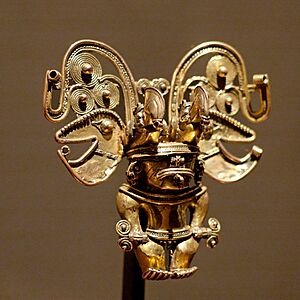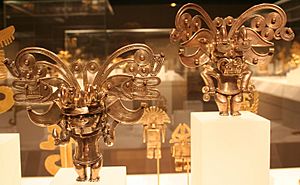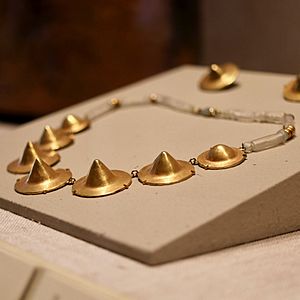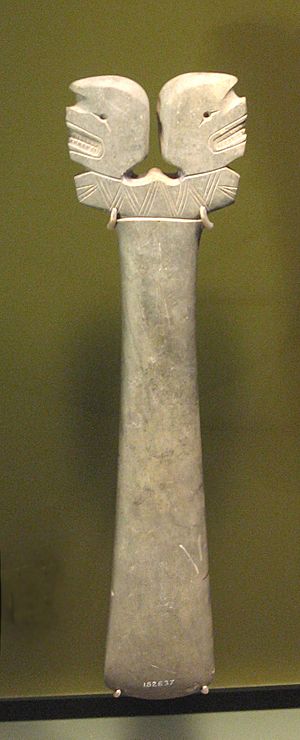Tairona facts for kids
The Tairona (also spelled Tayrona) were an ancient culture in Colombia, South America. They lived in the Sierra Nevada de Santa Marta mountains and nearby areas. Their history goes back to at least the 1st century AD. They grew a lot in numbers around the 11th century.
The Tairona people were part of the Chibchan language family. Another big group in this family was the Muisca. Evidence shows people lived in this area since at least 200 BC. They cleared forests and grew crops like yuca and maize. People lived on the Colombian Caribbean coast even earlier, around 4000 BC.
When the Spanish first arrived, the Tairona were mostly tolerant. But by 1600 AD, fights increased. Some Tairona moved higher into the mountains. This helped them avoid the Spanish colonial system. Today, the Kogi, Wiwa, Arhuacos, and Kankuamo people are believed to be direct descendants of the Tairona.
Contents
What Does "Tairona" Mean?
The name "Tairona" has similar words in the languages of people living in the Sierra Nevada today. In Sanca, it's Teiruna. In Kankuamo, it's Teijua or Tairuna. In Ijka, it's Teruna. All these words mean "Males" or "sons of the Jaguar."
The name Tairona might not be perfectly accurate for all the groups. But it became the most common name for these villages. At first, it referred to people from a valley called Tairo. By the 16th century, the Spanish used it for all the groups in the area.
Where Did the Tairona Live?
The Tairona lived in the region from about 200 BC until the 17th century. Then, they were forced into the Spanish Encomienda system. This system made them work for the Spanish.
The oldest Tairona sites are along the coast. They were settled around 200 BC. Sites higher up in the mountains, like those at 1,200 meters (about 3,900 feet), came later. Coastal areas like Chengue, Neguanje, Gayraca, Cinto, and Buritaca were lived in for a very long time.
We learn about the Tairona from old ruins and a few Spanish writings. One of the first descriptions was by Peter Martyr d'Anghiera in 1530. He said the Tairona valleys were full of people. They had large fields with irrigation systems, like those in Tuscany. Many villages focused on fishing. They traded fish for other things they needed.
Anghiera also wrote that the Tairona fought back strongly. The Spanish tried to take women and children to force them to work. This led to very violent first meetings. The Spanish lost many people. So, the first governor of Santa Marta, Rodrigo de Bastidas, tried a more peaceful approach.
Tairona Cities and Villages
One of the most famous Tairona cities is Ciudad Perdida, which means "Lost City." It was a large city, about 13 hectares (32 acres) in size. People found it in 1975. Now, the Colombian Institute of Anthropology and History takes care of it.
Studies suggest that about 1,600 to 2,400 people lived there. They lived in about 184 round houses. These houses were built on stone terraces. There are many other Tairona sites that are just as big or even bigger.
Another large site, Pueblito, is near the coast. It has at least 254 terraces. About 3,000 people lived there. Even larger villages like Posiguieca and Ciudad Antigua were on the western side of the Sierra Nevada de Santa Marta.
Smaller villages were connected by stone-paved paths. They were part of a strong trading network. Some villages specialized in making salt or fishing. Chengue, in Parque Tairona, was one such village. It had about 100 terraces and 800 to 1,000 people by 1400.
The Tairona were skilled builders. They built stone terraces, house foundations, stairs, sewers, tombs, and bridges. They also made a lot of pottery. Some pottery was for daily use, and some was for special ceremonies.
Tairona Art and Crafts
The Tairona made pottery from 200 BCE to 1650 CE. There is evidence of pottery on the Colombian Caribbean coast from 2500 BCE. Studies show that Tairona pottery changed over time.
The Tairona are most famous for their amazing goldwork. The earliest gold items are from the Neguanje Period (about 300 to 800 AD). Gold was used by many people, not just the leaders. They made pendants, nose ornaments, necklaces, and earrings.
The Tairona used a special mix of gold, silver, and copper called Tumbaga. They poured this melted mix into detailed molds. They also had a way to make the surface look like pure gold.
Their gold pendants, called "caciques," are very special. They show human figures, probably their spiritual leaders. These figures wear fancy clothes and animal masks. Their body language often looks strong and powerful. Some believe this shows the power of the wearer and that the Tairona were a strong society. Recent findings also suggest these figures show a process called 'transformation'. Leaders would wear special ornaments to look like bats. They believed this helped them gain power and see a deeper truth.
Tairona Revolt and Today's Descendants
In 1599, the Tairona fought against the Spanish. They were tired of the Spanish economic and religious demands. They attacked priests and travelers on the roads. They also targeted churches and homes of Spanish officials.
Spanish records from a trial in 1602 tell us about these events. The leaders of Chengue and Bonda were sentenced to death. Their villages were burned. Many people were moved and forced into the Encomienda system. By the mid-17th century, many Tairona towns were empty. The forest grew over the region.
Today, the Kogi, Arhuaco, Wiwa, and Kankuamo are the descendants of the Tairona. They still live in the Sierra Nevada de Santa Marta.
|
See also
 In Spanish: Taironas para niños
In Spanish: Taironas para niños






